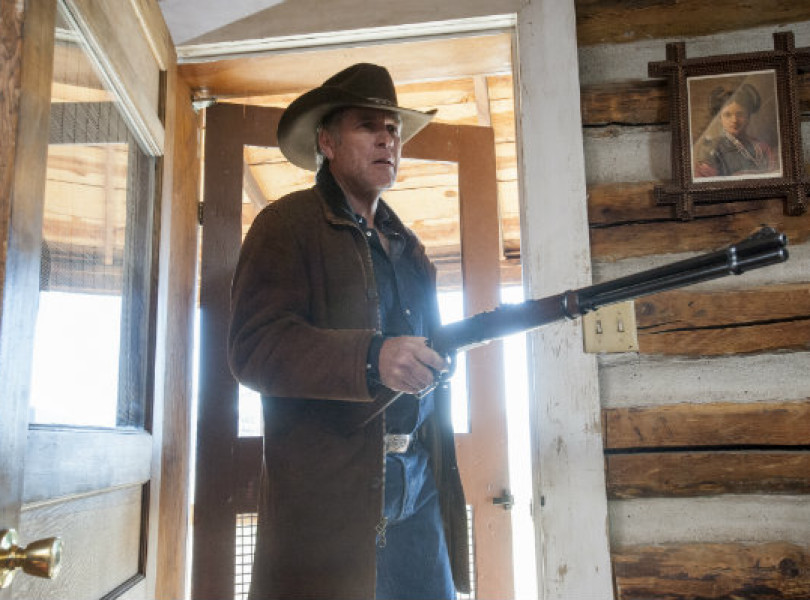Wide open spaces.
By Matt Fowler
As many of you know already, Longmire, the enjoyable, decently-rated crime series cancelled by A&E for skewing too old in the demo, was saved and gifted with a Season 4 by Netflix. All 10 new episodes debuted this week (with the first three seasons also available for binging) giving fans much needed relief from the cliffhanger that rocked the end of the Season 3 finale. A “gunshot” mystery that would have gone unanswered had it not been for the revival, leaving Longmire in the TV hell known as “shows that never got an ending.”
But it’s back. Long live the Longmire. A show that was smart enough, for the most part, to step up and out of its procedural roots more and more each year. Granted, that aspect isn’t gone from the show, even in this fourth season on Netflix. Though it is diminished. There are still “case of the week” aspects (though “week” doesn’t seem to fit now that you can watch all the episodes in one swoop), but the show figured out a way to better incorporate the side cases into the larger arcs, with only a few outliers here and there.
I won’t go into full spoilers for this Season 4 review. I’ve absorbed all 10 episodes and those who wish to know my thoughts regarding specific details can head over to the Longmire Spoiler “What Did You Think Of The Ending?” page. This review here will speak in broad, vaguer terms so someone can read it without getting certain story elements ruined for them.
Up front, I’ll say that I’m not a huge fan of procedurals. But I occasionally would allow myself to take in a a few mystery shows over the summer months. Side viewing. Shows that I could, if need be, watch out of the corner of my eye while doing other work. Of course, this was back when summer itself wasn’t overstuffed with programming. But that’s how I started watching Longmire (along with Perception and a few other case shows). The pilot episode impressed me so I stuck with it.
The Wyoming setting, along with the Cherokee themes and politics that came with the land, also helped the show stand apart. Plus, I’ll watch anything Katee Sackhoff’s in, and here she was in her first big TV gig since BSG. Yes, there were disposable episodes, but that’s just me speaking as someone who much prefers serialized stories to one-and-done “whodunnits.” It was Season 3 though when the larger serialized arcs really began to pick up. Driving the whole show was the mystery surrounding Sheriff Longmire’s wife’s death and by the end of the Season 3, we got the answer. And that dynamic, plus Bailey Chase’s spiral into self-destruction and obsessiveness as the once-privileged Deputy Branch Connally was an inspired arc.
So how do I write this review without giving away the outcome of the Season 3 gunshot? Well, I can’t really, I suppose. I mean, I’m not going to spell out the answer, but discerning minds can pick up on it. And read IMDB pages and all that. What I will say though is that the first episode back, “Down by the River,” answers all your questions in a rather riveting, powerful way. In fact, the way it singularly focused on one big story element made me wonder, heading into Season 4, if the show had decided to shed its “case of the episode” skin altogether.
But it didn’t. By the second episode, “War Eagle,” the murder mysteries had returned. And with the new episodes now lasting anywhere from 10 to 20 minutes longer than we were used to back on AMC, sometimes the show lingered to long in these pockets.
But, structurally, the first three episodes felt like the last three episodes of Season 3 (which was only 10 episodes and not 13 like Season 2 was). And it’s specifically with episode four, “Four Arrows,” that things start feeling like a new, fourth season. The way “Four Arrows” plays out, it feels like a re-pilot. In fact, thematically and stylistically, there are parts that mirror the actual pilot back in 2012.
So the first three episodes here, which includes the great “Down by the River” and “High Noon,” act as the official wrap up to last season and then new stories officially kick in afterward. New stories that involve a new casino, a shady oil rig operation, Sackhoff’s Vic falling for a deputy in the next county over (Dexter’s Josh Cooke), a rape victim seeking justice (Julia Jones), and a possible new love interest for Walt in the form of Profiler’s Ally Walker. And again, while the side cases still remain, they’re diminished and/or much better woven into the tapestry of the larger conspiracies.
Longmire: Season 4 Photo Gallery

Longmire: Season 4 Photos

Longmire: Season 4 Photos
Longmire: Season 4 Photos
Longmire: Season 4 Photos
Longmire: Season 4 Photos
Advertisement
Longmire: Season 4 Photos
Longmire: Season 4 Photos
Longmire: Season 4 Photos
Longmire: Season 4 Photos
Longmire: Season 4 Photos
Advertisement
Longmire: Season 4 Photos
Longmire: Season 4 Photos
Longmire: Season 4 Photos
Longmire: Season 4 Photos
Longmire: Season 4 Photos
Advertisement
Longmire: Season 4 Photos
Longmire: Season 4 Photos
Longmire: Season 4 Photos
Longmire: Season 4 Photos
Longmire: Season 4 Photos
Advertisement
Advertisement
Advertisement
A new possible love interest for Walt, eh? Well then what ever became of Vic’s feeling for him? You might ask. Perhaps. As awkward as that May/December “no”mance may have been for some viewers. Well, the season starts out leaning very heavily into it, but then swiftly kicks it to the side due to all the dire happenings. Again, if you watch the show, you know the powder keg Season 3 left us with. And so that’s used to sort of throw a fire blanket over the weird “Will They?/Won’t They?” deal that was bubbling up last year. An angle I had mixed feeling about, though well-supported by two fine actors.
There are just too many big things going on as we enter Season 4 for this type of “peace time” silliness to stick. So it gets shuffled back into the deck. Oh, it comes up later when it becomes clear that there are unspoken and unaddressed feelings/issues between Walt and Vic, so it’s not gone for good. Which, in a way, I’m happy about because I also don’t like it when shows drop a prominent storyline completely.
Vic’s sort of an odd TV character anyhow. I mean, she seems tailor-made to be the gal who eventually winds up with the lead, but we all seem to want much more for her than that. She entered the show with a husband who we didn’t even meet until seven episodes in. And her relationship with him was rocky to boot. You add to that the fact that Walt entered the show as a widow and – boom! – it seems like a perfect combo. But it’s not. And I think the show gets that. At least more so this season. That’s not to say they won’t wind up together down the line, but at least steps are being taken to make it feel more earned, and believable, if it did.
The standout arc this season, however, belongs to Lou Diamond Phillips’ Henry, who underwent a transformation from victim to vigilante, slowly taking up Hector’s mantle as the resident odds-evener for the reservation’s downtrodden and unfortunate. It’s a really well-crafted, emotional story that takes its time building towards something great. It makes sense and it hits home, and Henry’s saga with a young “Rez” girl named Gabby (aforementioned Julia Jones) stands as a seasonal highlight. Along with the fact that everything Walt, Henry, Nighthorse, and a local heavy played by Callum Keith Rennie (BSG alum!) winds up intersecting by the end of the 10.
Season 4 is definitely Longmire’s best season. Adequate praise, I think, for a show that’s improved year-over-year. Constantly finding its balance between blow off mysteries and engrossing character drama. Does it leave room for more? For a Season 5? As in, did the producers treat this miracle season on Netflix as a way to wrap everything up completely? Well, I’ll leave that chat for the “What Did You Think Of The Ending?” page for those who’ve finished the season and aren’t afraid of spoilers. In fact, there’s an entire new character on the show I didn’t even bring up in this review because his mere existence is a spoiler. So make sure to head to that page if you want detailed thoughts on crucial plot points.
Longmire returned with a gripping, confident season that really – considering the shift to Netflix – changed very little. It may have become more serialized, sure, but that’s pretty much the trajectory the show had been on over the past few years. The episodes were longer, but that only felt like an occasional strain.
Most of Season 3’s lingering story was wrapped up before Season 4 got to its halfway point, so Longmire really used this season to close off those threads and kick up all new storylines. And while there may have been times the series lapsed into cliche and investigative drudgery, there were also times that were just riveting. A Cherokee sweat lodge ceremony at the end of episode six, “The Calling Back,” immediately springs to mind.











